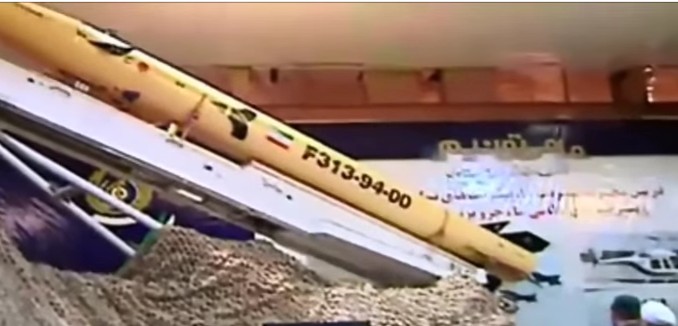Israel is keeping a “very sharp eye” on Iran’s expanding stock of highly accurate Fateh 313 ballistic missiles, which have twice the range of their predecessor, the Fateh 110, according to an Israeli defense official quoted Saturday in an article published in Defense News.
“We assess that Iran has begun to stockpile them,” the official said of the 500-kilometer-range, solid-fueled missile, unveiled in Aug. 22 ceremonies for National Defense Industry Day in the presence of Iranian President Hassan Rouhani. “You can be sure we are monitoring any attempt to move these out of the country by air, land or sea.”
He added, in a not-so-cryptic reference to the multiple times weapon shipments have either been seized on the high seas or attacked by air, “Our red lines are very clear to all and we are obliged to act on them.”
Defense News quoted Tal Inbar, a missile expert who heads the Space Research Center at the Fisher Institute for Strategic Air & Space Studies, as saying that the Fateh 313 missile reflects a growing sophistication in Iran’s aerospace industry. Inbar speculated that the extended range may be the result of lightening the payload, but that the longer range “means that from the farthest point in Lebanon, this missile can accurately hit high-value targets throughout Israel.”
According to a recent profile of the weapon published on Jane’s Defence Weekly, the extended range allows Iran to strike more targets while making the missile’s launchers more difficult to destroy.
A 67% increase in range from 200 km to 500 km would be a major step forward for Iran’s missile programme. It would allow Iran to target more military facilities in the Arab Gulf states with solid-fuel short-range ballistic missiles, allow targets to be attacked from different angles, and/or increase the amount of Iranian territory from where the missiles could be launched, making their transporter-erector-launcher (TEL) vehicles harder to locate and destroy.
The accuracy and range of the missile make it essential that the Lebanon-based Hezbollah does not acquire it.
Uzi Rubin, the founding director of the [Ministry of Defense’s] Israel Missile Defense Organization, told Defense News that if the missile remains in Iran, it poses a threat to much of Saudi Arabia and other Persian Gulf states.
Defense News further noted that Iranian leaders have been reportedly affirming their commitment to increasing Tehran’s support of regional allies after signing the Joint Comprehensive Plan of Action (JCPOA).
Former Pentagon official Michael Rubin wrote on Monday that Iran regarded the lifting of sanctions as a means of improving its own arsenals.
At the unveiling of the Fateh 313 missile last week, Iran’s President Hassan Rouhani declared that Tehran “will not ask for permission or abide by any resolution” in its quest to upgrade its military capabilities. His declaration was thought to be directed at the American interpretation of United Nations Security Council Resolution 2231, which implements the JCPOA, as restricting Iran from developing ballistic missiles.
[Photo: ali javid / YouTube ]




